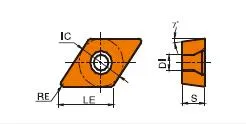

DCGTインサート
DCGTチップ角度:7° 片面チップブレーカー付きポジティブ・レーキ・チップ
55°ひし形ターニングインサート;
主な被削材アルミニウム
ブレーカー用途半仕上げ加工および仕上げ加工;
適合ターニングツールホルダーSDQCR/L、SDCR/L;
DCGTインサート寸法:DCGT0702/DCGT11T3;
材質:タングステンカーバイド;
DCGTインサート仕様
長いチッピング材の切りくずを制御するための高いポジティブすくい面を持つ仕上げ形状。
DCGTインサートツールホルダー


DCGTインサート紹介
- D: 形状。ひし形(ダイヤモンド)で、含まれる角度は55度。
- C: クリアランスアングル。7度(正)。
- G: 公差。ミディアム('G')が標準だが、他の精密公差もある。
- T: チップブレーカーのスタイルと穴の構成。この文字は、チップブレーカーの形状と、インサートに穴があるかないかを示します。チップブレーカーのバリエーションは多数あり、メーカーごとに異なります。
- 数字の桁数:
- 最初の2桁 内接円(IC)の直径をミリメートルで表したもの。おおよそのインチ換算値を得るには、この数値を25.4で割る。
- 次ページ2桁: ミリメートル単位の厚さ。25.4で割ってインチに変換する。
- 下2桁 ノーズ半径(ミリメートル)。インチに変換するには25.4で割る。
DCGTインサート寸法(ISO)
| ISO指定 | インサイテッド・サークル(IC) | 厚さ | コーナー半径 |
|---|---|---|---|
| DCGT 070202 | 7.94mm(0.313インチ) | 2.38mm(0.094インチ) | 0.2mm(0.008インチ) |
| DCGT 070204 | 7.94mm(0.313インチ) | 2.38mm(0.094インチ) | 0.4mm(0.016インチ) |
| DCGT 11T302 | 11mm(0.433インチ) | 3.18mm(0.125インチ) | 0.2mm(0.008インチ) |
| DCGT 11T304 | 11mm(0.433インチ) | 3.18mm(0.125インチ) | 0.4mm(0.016インチ) |
| DCGT 11T308 | 11mm(0.433インチ) | 3.18mm(0.125インチ) | 0.8mm(0.031インチ) |
例DCGT 11T308
- ひし形(菱形)、含み角55度
- 7度のポジティブ・クリアランス・アングル
- ミディアム・トレランス
- メーカー固有のチップブレーカーとホール構成
- 内接円直径11mm(インチで約0.43)
- 3.18mm厚(インチで約0.125)
- ノーズ半径0.8mm(インチで約0.031インチ)
超硬インサートの科学:その製造方法と強さの理由
超硬チップは、最も多用途で耐久性のある切削工具のひとつです。しかし、どのように作られるのでしょうか?また、なぜこれほど強いのでしょうか?このビデオでは、炭化タングステンの特性から製造工程まで、超硬チップの背後にある科学を探ります。
生産能力










